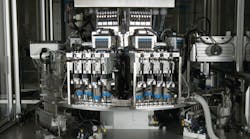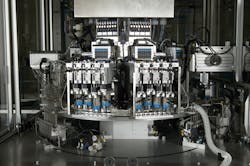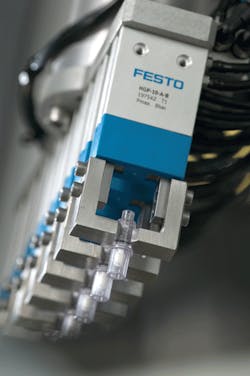Automation specialist PCE Automation Ltd., Beccles, England, offers a unique high-speed machine for testing medical inflation check valves. The one-way valves are used by the medical device industry to inflate or deflate balloons or cuffs, which are built into critical airway management devices such as endotracheal tubes, tracheostomy tubes and urology catheters.
The valve testing machine — which forms part of a modular production system — makes extensive use of Festo HGP parallel grippers to help accelerate the manufacturing process, and achieves a very high throughput of 240 valves per minute.
PCE Automation developed the valve testing machine for Bespak, one of the UK’s leading manufacturers of drug delivery devices.
The valve testing machine is a fully integrated standalone system comprising ten separate stages, or stations, on a rotary indexer, each of which features independent control. Because the machine forms part of a medical device manufacturing line, with rigidly-controlled process quality, all testing must be 100% accurate and both the test procedures and the control software need to be fully compliant with Failure Modes and Effects Analysis (FMEA) criteria.
PCE Automation chose the HGP grippers because of their cost and ability to operate cleanly with reliable, high-speed actuation.
HGP grippers are available in 16- and 25-mm sizes, 80 to 120 N of force per gripper jaw. They have stroke lengths of 5 to 7.5 mm per gripper jaw.
Bespak operates four valve assembly lanes concurrently, to maximize manufacturing throughput. The plastic valves are fed straight from all four assembly lines to the testing station, in batches of two valves per lane — i.e. 8 valves at a time — thereby preserving the same lane flow path to ensure process traceability.
The machine’s first two stations handle product loading and air-blast cleaning, while the next two handle tensile strength pull tests to check that the caps have been securely welded to the valves’ bodies. Station 5 initially checks the valves for the presence of adaptors, and then performs functional testing of valve operation. Stations 6 and 7 perform high-speed leak tests on the valves, checking that the valve seal is both present and working correctly.
PCE Automation has developed highly innovative leak detection hardware and result processing software to dramatically accelerate this aspect of valve testing, with the result that the machine can accurately detect leaks with flow rates as low as 2 cc/min in less than 1 sec. Station 7 also checks that the valve spring has been correctly fitted, and that there is no extrusion flash on the valve cap.
Valves are off-loaded from the testing machine by station 8, which discharges the tested devices into ‘passed’ or ‘failed’ tubes. This station also accommodates product sampling, enabling a complete table of valves to be discharged for further inspection. Station 9 carries out air blast and vacuum cleaning, and station 10 conducts an inspection of the valve nests to ensure that they are empty before the rotary table indexes round to the assembly feed area again, ready for the next valve on-load and test cycle.
Visit www.festo.com for more details on the pneumatic grippers. Visit www.pce-automation.co.uk for more details on the valve testing machine.



